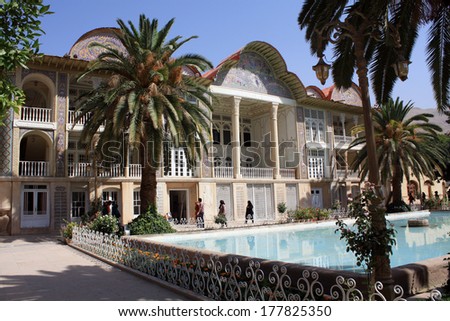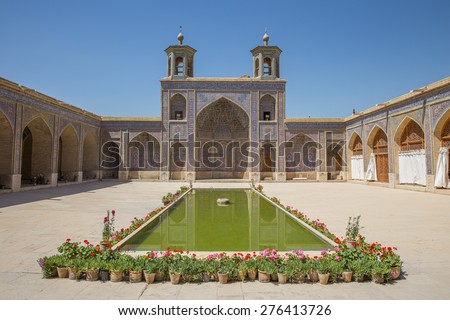IRAN, SHIRAZ HUB OF CULTURE
SHIRAZ
HUB OF CULTURE
WELCOME TO SHIRAZ
Celebrated
as the heartland of Persian culture for over 2000 years, Shiraz has become synonymous
with education, nightingales, poetry and wine. It was one of the most important
cities in the medieval Islamic world and was the Iranian capital during the
Zand dynasty (AD 1747–79), when many of its most beautiful buildings were built
or restored.
A city of poets, Shiraz is home to the graves of Hafez and Sa’di, both
major pilgrimage sites for Iranians. It’s also home to splendid gardens,
exquisite mosques and whispered echoes of ancient sophistication that reward
those who linger beyond the customary excursion to nearby Persepolis – the
area’s major tourist destination.
There are the usual Iranian traffic issues, but the city’s agreeable
climate, set in a fertile valley once famed for its vineyards, makes it a
pleasant place to visit (except at the humid height of summer or the freezing
depths of winter).
Attractions
Top Choice Palace in Shiraz
Garden in Shiraz
Bagh-e Naranjestan
Named after the bitter oranges that line the central courtyard, this is
Shiraz’s smallest but most lovely garden. Enclosing the delightful Naranjestan-e
Ghavam Pavilion it was laid out as part of a complex owned by one of Shiraz’s
wealthiest Qajar-era families. The pavilion’s mirrored entrance hall opens onto
rooms covered in a myriad of intricate tiles, inlaid wooden panels and
stained-glass windows. Particularly noteworthy are the ceilings of the upstairs
rooms, painted with European-style motifs, including Alpine churches and busty
German frauleins.
Built for the wealthy and powerful Mohammad Ali Khan Qavam al-Molk
between 1879 and 1886 as the buruni (public reception area) of his
family home, the pavilion is connected to the Khan-e Zinat ol-Molk, which housed the family’s andaruni
(private quarters), by an underground passage (not open to the public).
The basement of the pavilion houses an archaeological collection put
together by Arthur Upham Pope, an American scholar who taught at the Asia
Institute in Shiraz between 1969 and 1979. There is also an excellent selection
of handicrafts for sale in the basement, including miniatures painted on camel
bone and tiles inspired by antique designs.
Those looking to take part in the current craze for dressing up in
Qajar-era costume can do so at the booth in the corner of the courtyard.
Receiving the last rays of the day’s sun, the teahouse here is a good spot to
enjoy the light fading over the garden wall; it also sells delicate tinctures
of rose- and pomegranate-flavoured jellies.
 https://thumb1.shutterstock.com/display_pic_with_logo/1946966/177825350/stock-photo-bagh-e-narenjestan-garden-shiraz-iran-177825350.jpg
https://thumb1.shutterstock.com/display_pic_with_logo/1946966/177825350/stock-photo-bagh-e-narenjestan-garden-shiraz-iran-177825350.jpg
Mosque in
Shiraz
Masjed-e Nasir Al Molk
One of the most
elegant and most photographed pieces of architecture in southern Iran, the Pink
Mosque was built at the end of the 19th century and its coloured tiling (an
unusually deep shade of blue) is exquisite. There are some particularly fine muqarnas
in the small outer portal and in the northern iwan, but it is the
stained glass, carved pillars and polychrome faience of the winter prayer hall
that dazzle the eye when the sun streams in.
The mosque attracts most visitors early in the morning (9am to 11am is
best) when the hall and its Persian carpets are illuminated with a kaleidoscope
of patterned flecks of light. It makes for a magical experience – and an
irresistible photograph.
A museum in the opposite prayer hall opens into the Gav Cha (Cow Well),
where cows were used to raise water from the underground qanat. The
structure has survived numerous earthquakes, due in part to its construction
using flexible wood as struts within the walls – look for the wooden bricks in
the iwan columns. The rose-pink floral tiles are a signature feature of
Shiraz.

https://thumb1.shutterstock.com/display_pic_with_logo/2417960/276413726/stock-photo-nasir-al-mulk-mosque-in-shiraz-iran-276413726.jpg

https://i.pinimg.com/736x/09/f4/0f/09f40fcbd8674e0602cbc12ea54f61a6--l-iran-shiraz-iran.jpg
CONTENT from Lonely Planet and Gazelle

https://thumb1.shutterstock.com/display_pic_with_logo/2417960/276413726/stock-photo-nasir-al-mulk-mosque-in-shiraz-iran-276413726.jpg
Places in Shiraz
Naranjestan-e Ghavam Pavilion
Set within an
exquisite garden, Bagh-e
Naranjestan, this pavilion
was built for the wealthy and powerful Mohammad Ali Khan Qavam al-Molk between
1879 and 1886 as the buruni (public reception area) of his family home.
The pavilion is connected to the Khan-e Zinat ol-Molk, which housed the
family’s andaruni (private quarters), by an underground passage (not
open to the public).
The basement of the pavilion houses an archaeological collection put
together by Arthur Upham Pope, an American scholar who taught at the Asia
Institute in Shiraz between 1969 and 1979. There is also an excellent selection
of handicrafts for sale in the basement, including miniatures painted on camel
bone and tiles inspired by antique designs.

https://i.pinimg.com/736x/09/f4/0f/09f40fcbd8674e0602cbc12ea54f61a6--l-iran-shiraz-iran.jpg
Gardens in Shiraz
Bagh-e Nazar
This formal garden encompasses an octagonal pavilion, which is now home to
the Pars Museum. Karim Khan once received foreign
dignitaries in the pavilion, which, with its stunning stalactite ceiling and
delightful murals of lovers courting, scholars reading and horsemen hunting, is
a highlight in its own right. Exhibits include Karim Khan Zand’s sword and some
interesting old ceramics.
CONTENT from Lonely Planet and Gazelle




Comments
Post a Comment